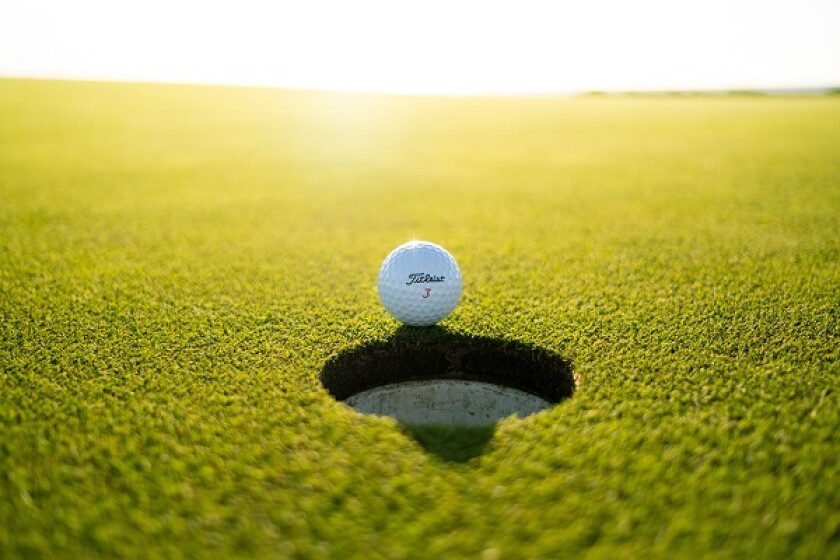Golf is a game of precision. You start by hitting a powerful shot to try to get the ball close to the green. At the moment of the first shot (the ‘drive’), the hole flag is still quite far away and sometimes can barely be seen. You do not expect to put the ball in the hole and it is fine to get closer to stay in the game. Then, you hit a second shot (the ‘approach’), a more precise one, to have the ball arrive nearer to the pin. Finally, you target the hole and put the ball in the cup (the ‘putt shot’). On a par-3 hole, a player may hit the pin in three shots.
After decision G1/19, inventive step assessment for computer-implemented invention (CII) is like a par-3 hole, you have to get there in three shots. With the first shot, the applicant must overcome the first hurdle, i.e. eligibility under Article 52 of the European Patent Convention (EPC). With the second shot, the applicant must be more accurate and identify more precisely which features contribute to the technical character of the invention. Finally, with the third shot, the applicant must put the ball in the hole, i.e. must prove inventive step over the closest prior art.
According to G1/19 (point 39), the two-hurdle approach for CII actually entails three steps, wherein establishing whether a feature contributes to the technical character of the invention constitutes an intermediate step between assessing (i) the invention eligibility under Article 52 EPC and (ii) whether the invention is based on an inventive step vis-à-vis the closest prior art.
|
|
“Unlike US patent law, the EPC does not provide for any statutory categories and it establishes that an invention is patentable as long as it is ‘technical’.” |
This additional intermediate step serves as a filter for features contributing to a technical solution of a technical problem in view of the closest prior art. Only those distinguishing features can contribute to inventive step.
The first shot – ‘drive’: invention eligibility
An invention is eligible, if it has ‘technical character’.
Unlike US patent law, the EPC does not provide for any statutory categories and it establishes that an invention is patentable as long as it is ‘technical’. Unfortunately, ‘technical’ is not defined either in the EPC, nor in the case law.
In general, it is commonly acknowledged that an invention has technical character to the extent that it relates to a technical field, it concerns a technical problem, it has technical features in terms of which the matter for which protection is sought can be defined in the claims or results in a technical effect. This acknowledgment still might appear obscure, hence examples are more useful for gaining hindsight of what can be ‘technical’.
As far as software is concerned, ‘technical’ can be, e.g. processing physical data parameters or control values of an industrial process; processing which affects the way a computer operates (increasing speed, enhancing memory); the physical features of an entity (disk, port, database). On the other hand, ‘non-technical’ is, e.g. processing non-physical data, such as monetary values, business data, graphical presentations and text.
To assess eligibility (patentability), a claim must be considered ‘as a whole’, regardless to the state of the art. Thus, a general and holistic approach to the subject matter must be held, rather than an atomistic and detailed examination of the claimed features. Such an examination will come at the second step.
An invention has ‘technical character’, if the recitations make it clear that the subject matter ‘as a whole’:
Serves a concrete purpose in the real world, including computer hardware;
Serves a ‘further’ purpose as a result of the implementation of some aspects in the ‘virtual’ (numerical) world, i.e. it is indirectly, but unambiguously, able to provide for an impact in the real world; or
Contains physical features. In this latter regard - probably for the first time ever in such clear terms – decision G1/19 has explicitly stated that ‘physical’ or ‘tangible’ features are anyway not essential to confer technical character to the claimed subject-matter. On the other hand, however, the claimed features must not be obscure, vague or abstract.
The second shot – ‘approach’: features contributing to technicality
Once the first shot has been taken, time has come to be precise and get close to the hole. In this step, a claim is compared, vis-à-vis, with the state of the art, to identify those novel features which distinguish the claimed subject matter from the closest prior art.
From these novel features, only those that are ‘technical’ can be taken into account in assessing inventive step. In this regard, decision G1/19 confirms and follows the COMVIK approach (T641/00), whereby only claim integers that contribute to the technical character of the claimed invention can contribute to inventive step.
A claim integer that is non-technical per se may, in some circumstances, be taken into account when evaluating inventive step, if in the context of the invention, contributes “to producing a technical effect serving a technical purpose, thereby contributing to the technical character of the invention” (EPO Guidelines for Examination, Part G, Chapter VII, 5.4).
With the aim of providing some guidance for the second shot of our golf game, features are ‘technical’ if:
They are ‘physical’ (concrete); however, generic wording introducing alleged ‘physical’ entities does not confer ‘technicality’. For example, expressions like ‘neural network’, ‘artificial intelligence’, ‘computational node’ are considered too vague, whereby the corresponding features are considered as ‘abstract’ and thus non-technical;
They are aspects providing an effect that ‘directly’ solves a problem in the real world (including computer hardware) and not, e.g. in administrative, financial or human-mind realm; or
They are aspects having a ‘specific’ (i.e. not vague) implementation, even if they are non-tangible. As such, aspects existing in the virtual world (e.g. AI, machine learning, simulation) are in principle admissible. Nevertheless, they can be ‘technical’ as long as they achieve a ‘further’ result, in the sense that the result is ‘indirectly’, but univocally, able to solve a problem in the real world and not in the administrative, financial, or human-mind world. A confirmation comes from point 50 of G1/19 saying that the criterion ‘technical effect going beyond the simulation implementation’ is understood to mean any ‘further’ technical effect going beyond the ‘normal’ physical interactions between the program and the computer on which the simulation is run. In addition, point 137 states that aspects of the model may contribute to technicality if, for example, they form the basis for a further technical use of the outcomes of the simulation (e.g. a use having an impact on physical reality).
In this latter regard, point 88 of G1/19 further states that there is no need to require a ‘direct link’ with (external) physical reality in every case. On one hand, technical contributions may also be established by features within the computer system used. On the other hand, there are many examples in which potential technical effects - which may be distinguished from direct technical effects on physical reality - have been considered in the course of technicality/inventive step analysis.
However, the technical nature of some effects inside the computer does not mean that the ‘downstream’ effects caused by the data output of the computer are necessarily of a technical nature. In addition, if claimed data or data resulting from a claimed process have relevant uses other than the use with a technical device (such as for controlling a technical device), it must be ascertained that a technical effect is achieved over substantially the whole scope of the claimed invention.
As an example, where a simulation involves training of autonomous vehicles, and the simulation is used to adjust braking profiles of the production vehicle, then the boundaries of the model (e.g. maximum braking force; coefficient of friction of rubber on tarmac, etc.) form the basis of a further technical use and will therefore contribute to the technical character of the invention.
The third shot – ‘putt’: inventive step vis-à-vis the prior art
Eventually, ready to hole!
We started from a distance and passed the first hurdle, namely invention eligibility under Article 52 EPC. Then, we hit an approach shot, more precise, and so we passed the second hurdle, i.e. identifying those novel features which, on one hand distinguish the claimed subject-matter from the closest prior art and, on the other hand contribute to the technical character of the invention.
Now, we are ready to put the ball in the cup by hitting a precise shot – ‘putt’ - that allows us to overcome the third hurdle, i.e. establishing whether those technical features provide for an inventive step over the closest prior art.
Decision G1/19 does not deviate from the so-called ‘problem-solution approach’, therefore the latter remains the legal framework for evaluating inventive step.
As known and referred to by G1/19 (point 26), the ‘problem-solution approach’ consists of the following steps:
1. Determining the ‘closest prior art’;
2. Assessing the technical results (or effects) achieved by the claimed invention, when compared with the ‘closest prior art’;
3. Defining the technical problem to be solved, the object of the invention being to achieve said result; and
4. Considering whether or not the claimed solution, starting from the closest prior art and the objective technical problem, would have been obvious to the skilled person.
As far as CII are concerned, it is common that the claimed subject matter contains a mixture of technical and non-technical features. In this regard, decision G1/19 has upheld the COMVIK approach, according to which an invention having technical character as a whole is to be assessed with respect to the requirement of inventive step by taking account of all those features which contribute to said technical character, whereas features making no such contribution cannot support the presence of inventive step.
|
|
“G1/19 has supplemented the previous two-hurdle approach with the intermediate step of establishing which features contribute to the technical character.” |
To this end, G1/19 has supplemented the previous two-hurdle approach with the intermediate step of establishing which features contribute to the technical character. Decision G1/19 has also confirmed previous case law that explicitly states that the COMVIK approach does not contradict the ‘problem-solution approach’, rather it is a special application of the ‘problem-solution approach’ to inventions that contain a mix of technical and non-technical features (T1503/12, point 3.3).
Have a good game
G1/19 has provided further guidance in determining whether or not CII are inventive over the prior art. A three-step pattern has entered the arena: (i) assessing eligibility of the subject matter ‘as a whole’, regardless to the state of the art; (ii) identifying which features contribute to the technical character, ‘physical’ features not being essential to confer ‘technical character’ and ‘further potential’’ technical effects being admissible for ‘technicality’; and (iii) applying the ‘problem-solution approach’.
Like a hole par-3 requires playing three shots, albeit with varying difficulty from course to course, so G1/19 requires a three-step pattern of reasoning to assess inventiveness: sometimes it can be easy, sometimes not. The fun is to play on different courses and measure yourself with increasing difficulties – therefore have a good game and keep training!

Marco Lissandrini
Managing partner
Bugnion
T: +39 045 8005310
E: marco.lissandrini@bugnion.eu
Marco Lissandrini is a managing partner at Bugnion. He started working at the firm in 2000 as a patent, trademark and design attorney, before becoming the head of the Verona office in 2010 and a partner in 2015. He has also sat on the firm’s board of directors.
Marco deals with the prosecution of patents, trademarks and designs and acts as a technical consultant on behalf of clients in cases of patents and utility models. Over the years, he has gained expertise in the engineering, aerospace and software sectors, dealing with different technologies, from food processing plants to laser sintering machines and three-dimensional printing. He has been a speaker at numerous conventions, both in Italy and abroad.
Marco is a graduate of aerospace engineering from the Polytechnic University of Milan.











